The COVID-19 Infodemic on Twitter: A Space and Time Topic Analysis of the Brazilian Immunization Program and Public Trust
Abstract
1. Introduction
- (1)
- What topics were discussed during 2020 and 2021 on COVID-19 immunization in Brazil?
- (2)
- What can be understood/interpreted about the extracted topics?
- (3)
- How did topics evolve over time?
- (4)
- How are they distributed in Brazilian territory, and which places have generated the most tweets?
2. Methods
- (1)
- Texts collection from Twitter
- (2)
- Texts preprocessing
- (3)
- Feature selection
- (4)
- Topic modeling and discovery
- (5)
- Spatio-temporal topic analysis
2.1. Texts Collection and Storage
- (1)
- Tweet text (text field)
- (2)
- Place name (place_name field)
- (3)
- Country name (country field)
- (4)
- Geographic coordinates (point field)
- (5)
- Creation date (created_at field)
2.2. Initial Treatment
2.3. Topic Model Setup
| Algorithm 1 Latent Dirichlet Allocation Generative Process | |
| 1. | For each document w in a corpus D: |
| 1.1 | Choose |
| 1.2 | Choose |
| 1.3 | For each of the N words wn: |
| 1.3.1 | Choose a topic |
| 1.3.2 | Choose a word wn from , a multinomial probability related to the topic zn |
2.4. Topic Analysis
- (1)
- Manual topic polarity labeling, dedicated to annotating the polarity trend associated with each topic into three types:
- (1)
- Supportive topic (pro), with positive relation, denoting trust about the COVID-19 vaccination.
- (2)
- Negationist or unsupportive topic (anti), with negative relation, denoting mistrust about vaccination.
- (3)
- Neutral topic (neutral), not associated with the types above.
- (2)
- Geographical Topic Analysis is dedicated to visualizing and understanding the topics’ distribution in a geographic area. There are two possible ways to perform this analysis [52]: (1) discovering different topics of interest that are coherent across geographic regions and (2) comparing several topics across different geographical locations.
- (3)
- Time Topic Analysis is dedicated to visualizing and understanding the topics’ distribution over time. One example of this application can be seen in the study by Martin et al. [53].
3. Results and Discussion
3.1. General Findings
3.2. Topic Modeling Results
- (1)
- For the words vector obtained with the count method: a topic model with only three components (topics), using a learning decay equals 0.7. This result is corroborated by the best log-likelihood of −840,183.6751 and perplexity of 1479.7684.
- (2)
- For the words vector obtained with TF-IDF method, a topic model with only three components, and in this case, using a leaning decay equals 0.5. This result is corroborated by the log-likelihood of −281,057.5610 and perplexity of 4225.0856.
3.3. Topic Analysis Findings
- vaccineyes → vaccine yes
- vaccineforeverybody → vaccination for everybody
- vaccinenow → vaccine now
- outbolsonaro → out Bolsonaro (the family name of the Brazilian president at the time this study was carried out)
- hailthesus → hail the SUS (the last part is the acronym for Sistema Unico de Saúde, the Brazilian Public Health System)
- comevaccine → come vaccine
3.3.1. Manual Annotation Results
3.3.2. Topics Timeline
3.3.3. Topics in Brazilian Geographic Space
3.4. Theoretical and Practical Implications
3.5. Difficulties, Challenges, and Limitations
4. Final Considerations
Further Research
Supplementary Materials
Author Contributions
Funding
Data Availability Statement
Acknowledgments
Conflicts of Interest
References
- Dwivedi, Y.K.; Hughes, D.L.; Coombs, C.; Constantiou, I.; Duan, Y.; Edwards, J.S.; Gupta, B.; Lal, B.; Misra, S.; Prashant, P.; et al. Impact of COVID-19 Pandemic on Information Management Research and Practice: Transforming Education, Work and Life. Int. J. Inf. Manag. 2020, 55, 102211. [Google Scholar] [CrossRef]
- Venkatesh, V. Impacts of COVID-19: A Research Agenda to Support People in Their Fight. Int. J. Inf. Manag. 2020, 55, 102197. [Google Scholar] [CrossRef] [PubMed]
- Boullosa, P.; Garea, A.; Area, I.; Nieto, J.J.; Mira, J. Leveraging Geographically Distributed Data for Influenza and SARS-CoV-2 Non-Parametric Forecasting. Mathematics 2022, 10, 2494. [Google Scholar] [CrossRef]
- Islam, A.K.M.N.; Mäntymäki, M.; Laato, S.; Turel, O. Adverse Consequences of Emotional Support Seeking through Social Network Sites in Coping with Stress from a Global Pandemic. Int. J. Inf. Manag. 2022, 62, 102431. [Google Scholar] [CrossRef] [PubMed]
- Chamakiotis, P.; Panteli, N.; Davison, R.M. Reimagining E-Leadership for Reconfigured Virtual Teams Due to COVID-19. Int. J. Inf. Manag. 2021, 60, 102381. [Google Scholar] [CrossRef]
- González-Padilla, D.A.; Tortolero-Blanco, L. Social Media Influence in the COVID-19 Pandemic. Int. Braz. J. Urol. 2020, 46, 120–124. [Google Scholar] [CrossRef] [PubMed]
- Gupta, P.; Kumar, S.; Suman, R.R.; Kumar, V. Sentiment Analysis of Lockdown in India during COVID-19: A Case Study on Twitter. IEEE Trans. Comput. Soc. Syst. 2021, 8, 939–949. [Google Scholar] [CrossRef]
- Huang, X.; Wang, S.; Zhang, M.; Hu, T.; Hohl, A.; She, B.; Gong, X.; Li, J.; Liu, X.; Gruebner, O.; et al. Social Media Mining under the COVID-19 Context: Progress, Challenges, and Opportunities. Int. J. Appl. Earth Obs. Geoinf. 2022, 113, 102967. [Google Scholar] [CrossRef]
- Imran, A.S.; Daudpota, S.M.; Kastrati, Z.; Batra, R. Cross-Cultural Polarity and Emotion Detection Using Sentiment Analysis and Deep Learning on COVID-19 Related Tweets. IEEE Access 2020, 8, 181074–181090. [Google Scholar] [CrossRef]
- Abdulaziz, M.; Alotaibi, A.; Alsolamy, M.; Alabbas, A. Topic Based Sentiment Analysis for COVID-19 Tweets. Int. J. Adv. Comput. Sci. Appl. 2021, 12, 626–636. [Google Scholar] [CrossRef]
- Alliheibi, F.M.; Omar, A.; Al-Horais, N. Opinion Mining of Saudi Responses to COVID-19 Vaccines on Twitter: A Computational Linguistic Approach. Int. J. Adv. Comput. Sci. Appl. 2021, 12, 72–78. [Google Scholar] [CrossRef]
- Aparicio, J.T.; Salema de Sequeira, J.; Costa, C.J. Emotion Analysis of Portuguese Political Parties Communication over the COVID-19 Pandemic. In Proceedings of the 2021 16th Iberian Conference on Information Systems and Technologies (CISTI), Chaves, Portugal, 23–26 June 2021; pp. 1–6. [Google Scholar]
- Cheng, I.K.; Heyl, J.; Lad, N.; Facini, G.; Grout, Z. Evaluation of Twitter Data for an Emerging Crisis: An Application to the First Wave of COVID-19 in the UK. Sci. Rep. 2021, 11, 19009. [Google Scholar] [CrossRef] [PubMed]
- Naseem, U.; Razzak, I.; Khushi, M.; Eklund, P.W.; Kim, J. COVIDSenti: A Large-Scale Benchmark Twitter Data Set for COVID-19 Sentiment Analysis. IEEE Trans. Comput. Soc. Syst. 2021, 8, 976–988. [Google Scholar] [CrossRef] [PubMed]
- Cotfas, L.-A.; Delcea, C.; Gherai, R. COVID-19 Vaccine Hesitancy in the Month Following the Start of the Vaccination Process. Int. J. Environ. Res. Public Health 2021, 18, 10438. [Google Scholar] [CrossRef]
- Melton, C.A.; Olusanya, O.A.; Ammar, N.; Shaban-Nejad, A. Public Sentiment Analysis and Topic Modeling Regarding COVID-19 Vaccines on the Reddit Social Media Platform: A Call to Action for Strengthening Vaccine Confidence. J. Infect. Public Health 2021, 14, 1505–1512. [Google Scholar] [CrossRef]
- Shi, W.-z.; Zeng, F.; Zhang, A.; Tong, C.; Shen, X.; Liu, Z.; Shi, Z. Online Public Opinion during the First Epidemic Wave of COVID-19 in China Based on Weibo Data. Humanit. Soc. Sci. Commun. 2022, 9, 159. [Google Scholar] [CrossRef]
- Mackey, T.; Purushothaman, V.; Li, J.; Shah, N.; Nali, M.; Bardier, C.; Liang, B.; Cai, M.; Cuomo, R. Machine Learning to Detect Self-Reporting of Symptoms, Testing Access, and Recovery Associated With COVID-19 on Twitter: Retrospective Big Data Infoveillance Study. JMIR Public Health Surveill. 2020, 6, e19509. [Google Scholar] [CrossRef]
- Daradkeh, M. Analyzing Sentiments and Diffusion Characteristics of COVID-19 Vaccine Misinformation Topics in Social Media: A Data Analytics Framework. Int. J. Bus. Anal. 2022, 9, 1–22. [Google Scholar] [CrossRef]
- Wang, L.; Xian, Z.; Du, T. The Public Information Needs of COVID-19 Vaccine: A Study Based on Online Q&A Communities and Portals in China. Front. Psychol. 2022, 13, 961181. [Google Scholar] [CrossRef]
- Zhu, J.; Weng, F.; Zhuang, M.; Lu, X.; Tan, X.; Lin, S.; Zhang, R. Revealing Public Opinion towards the COVID-19 Vaccine with Weibo Data in China: BertFDA-Based Model. Int. J. Environ. Res. Public Health 2022, 19, 13248. [Google Scholar] [CrossRef]
- Xie, Q.; Xue, Y.; Zhao, Z. Understanding the Scientific Topics in the Chinese Government’s Communication about COVID-19: An LDA Approach. Sustainability 2022, 14, 9614. [Google Scholar] [CrossRef]
- Zhou, Y.; Xu, J.; Yin, M.; Zeng, J.; Ming, H.; Wang, Y. Spatial-Temporal Pattern Evolution of Public Sentiment Responses to the COVID-19 Pandemic in Small Cities of China: A Case Study Based on Social Media Data Analysis. Int. J. Environ. Res. Public Health 2022, 19, 11306. [Google Scholar] [CrossRef] [PubMed]
- Leach, M.; MacGregor, H.; Akello, G.; Babawo, L.; Baluku, M.; Desclaux, A.; Grant, C.; Kamara, F.; Nyakoi, M.; Parker, M.; et al. Vaccine Anxieties, Vaccine Preparedness: Perspectives from Africa in a COVID-19 Era. Soc. Sci. Med. 2022, 298, 114826. [Google Scholar] [CrossRef] [PubMed]
- Luo, C.; Chen, A.; Cui, B.; Liao, W. Exploring Public Perceptions of the COVID-19 Vaccine Online from a Cultural Perspective: Semantic Network Analysis of Two Social Media Platforms in the United States and China. Telemat. Inform. 2021, 65, 101712. [Google Scholar] [CrossRef] [PubMed]
- da Fonseca, E.M.; Shadlen, K.C.; Bastos, F.I. The Politics of COVID-19 Vaccination in Middle-Income Countries: Lessons from Brazil. Soc. Sci. Med. 2021, 281, 114093. [Google Scholar] [CrossRef] [PubMed]
- Biancovilli, P.; Makszin, L.; Jurberg, C. Misinformation on Social Networks during the Novel Coronavirus Pandemic: A Quali-Quantitative Case Study of Brazil. BMC Public Health 2021, 21, 1200. [Google Scholar] [CrossRef] [PubMed]
- Caldarelli, G.; De Nicola, R.; Petrocchi, M.; Pratelli, M.; Saracco, F. Flow of Online Misinformation during the Peak of the COVID-19 Pandemic in Italy. EPJ Data Sci. 2021, 10, 34. [Google Scholar] [CrossRef] [PubMed]
- Germani, F.; Biller-Andorno, N. The Anti-Vaccination Infodemic on Social Media: A Behavioral Analysis. PLoS ONE 2021, 16, e247642. [Google Scholar] [CrossRef]
- Obadimu, A.; Khaund, T.; Mead, E.; Marcoux, T.; Agarwal, N. Developing a Socio-Computational Approach to Examine Toxicity Propagation and Regulation in COVID-19 Discourse on YouTube. Inf. Process. Manag. 2021, 58, 102660. [Google Scholar] [CrossRef]
- Stoler, J.; Klofstad, C.A.; Enders, A.M.; Uscinski, J.E. Sociopolitical and Psychological Correlates of COVID-19 Vaccine Hesitancy in the United States during Summer 2021. Soc. Sci. Med. 2022, 306, 115112. [Google Scholar] [CrossRef]
- Cotfas, L.-A.; Delcea, C.; Gherai, R.; Roxin, I. Unmasking People’s Opinions behind Mask-Wearing during COVID-19 Pandemic—A Twitter Stance Analysis. Symmetry 2021, 13, 1995. [Google Scholar] [CrossRef]
- de Carvalho, V.D.H.; Nepomuceno, T.C.C.; Poleto, T.; Turet, J.G.; Costa, A.P.C.S. Mining Public Opinions on COVID-19 Vaccination: A Temporal Analysis to Support Combating Misinformation. Trop. Med. Infect. Dis. 2022, 7, 256. [Google Scholar] [CrossRef] [PubMed]
- de Carvalho, V.D.H.; Costa, A.P.C.S. Public Security Sentiment Analysis on Social Web: A Conceptual Framework for the Analytical Process and a Research Agenda. Int. J. Decis. Support Syst. Technol. 2020, 13, 1–20. [Google Scholar] [CrossRef]
- Oliveira, W.C.C.d.; Reis, J.C.S.; Moro, F.B.M.M.; Almeida, V. Detecção de Posicionamento Em Tweets Sobre Política No Contexto Brasileiro. In Anais do Brazilian Workshop on Social Network Analysis and Mining (BraSNAM); Sociedade Brasileira de Computação—SBC: Natal, Brazil, 2018. [Google Scholar]
- de Carvalho, V.D.H.; Nepomuceno, T.C.C.; Poleto, T.; Turet, J.G. Ana Paula Cabral Seixas Costa Analyzing the Public Opinion Polarization about COVID-19 Vaccines in Brazil Through Tweets. In Proceedings of the 2021 International Conference on Decision Support System Technology; Choudhary, A., Jayawickrama, U., Spanaki, K., Delias, P., Eds.; EWG-DSS: Loughborough, UK, 2021. [Google Scholar]
- Honnibal, M.; Montani, I.; Van Landeghem, S.; Boyd, A. SpaCy: Industrial-Strength Natural Language Processing (NLP) in Python 2020. Available online: https://spacy.io/ (accessed on 24 November 2022).
- McKinney, W. Data Structures for Statistical Computing in Python. In Proceedings of the 9th Python in Science Conference (SciPy 2010), Austin, TX, USA, 28 June–3 July 2010; pp. 56–61. [Google Scholar]
- Pedregosa, F.; Varoquaux, G.; Gramfort, A.; Michel, V.; Thirion, B.; Grisel, O.; Blondel, M.; Prettenhofer, P.; Weiss, R.; Dubourg, V.; et al. Scikit-Learn: Machine Learning in Python. J. Mach. Learn. Res. 2011, 12, 2825–2830. [Google Scholar]
- Papadia, G.; Pacella, M.; Giliberti, V. Topic Modeling for Automatic Analysis of Natural Language: A Case Study in an Italian Customer Support Center. Algorithms 2022, 15, 204. [Google Scholar] [CrossRef]
- Blei, D.; Carin, L.; Dunson, D. Probabilistic Topic Models. IEEE Signal Process. Mag. 2010, 27, 55–65. [Google Scholar] [CrossRef] [PubMed]
- Blei, D.M.; Ng, A.Y.; Jordan, M.I. Latent Dirichlet Allocation. J. Mach. Learn. Res. 2003, 3, 993–1022. [Google Scholar]
- Hoffman, M.D.; Blei, D.M.; Bach, F. Online Learning for Latent Dirichlet Allocation. In Advances in Neural Information Processing Systems; Lafferty, J., Williams, C., Shawe-Taylor, J., Zemel, R., Culotta, A., Eds.; Curran Associates, Inc.: Red Hook, NY, USA, 2010. [Google Scholar]
- Srinivasan, B.; Mohan Kumar, K. Flock the Similar Users of Twitter by Using Latent Dirichlet Allocation. Int. J. Sci. Technol. Res. 2019, 8, 1421–1425. [Google Scholar]
- Sievert, C.; Shirley, K. LDAvis: A Method for Visualizing and Interpreting Topics. In Proceedings of the Workshop on Interactive Language Learning, Visualization, and Interfaces; Association for Computational Linguistics: Stroudsburg, PA, USA, 2014; pp. 63–70. [Google Scholar]
- Mabey, B.; English, P. PyLDAvis: Python Library for Interactive Topic Model Visualization 2015. Available online: https://pyldavis.readthedocs.io/en/latest/index.html (accessed on 24 November 2022).
- Liu, Q.; Chen, Q.; Shen, J.; Wu, H.; Sun, Y.; Ming, W.-K. Data Analysis and Visualization of Newspaper Articles on Thirdhand Smoke: A Topic Modeling Approach. JMIR Med. Inform. 2019, 7, e12414. [Google Scholar] [CrossRef]
- Chuang, J.; Manning, C.D.; Heer, J. Termite: Visualization Techniques for Assessing Textual Topic Models. In Proceedings of the International Working Conference on Advanced Visual Interfaces—AVI ’12, Capri Island, Italy, 21–25 May 2012; ACM Press: New York, NY, USA, 2012; p. 74. [Google Scholar]
- Bokeh Development Team Bokeh: Python Library for Interactive Visualization 2018. Available online: https://docs.bokeh.org/en/latest/ (accessed on 24 November 2022).
- van der Maaten, L.; Hinton, G. Visualizing Data Using T-SNE. J. Mach. Learn. Res. 2008, 9, 2579–2605. [Google Scholar]
- Maaten Van Der, L. Accelerating T-SNE Using Tree-Based Algorithms. J. Mach. Learn. Res. 2014, 15, 3221–3245. [Google Scholar]
- Yin, Z.; Cao, L.; Han, J.; Zhai, C.; Huang, T. Geographical Topic Discovery and Comparison. In Proceedings of the 20th International Conference on World Wide Web, Hyderabad, India, 28 March–1 April 2011; pp. 247–256. [Google Scholar] [CrossRef]
- Martin, S.; Kilich, E.; Dada, S.; Kummervold, P.E.; Denny, C.; Paterson, P.; Larson, H.J. “Vaccines for Pregnant Women…?! Absurd”—Mapping Maternal Vaccination Discourse and Stance on Social Media over Six Months. Vaccine 2020, 38, 6627–6637. [Google Scholar] [CrossRef] [PubMed]
- Vitório, D.; Souza, E.; Oliveira, A.L.I. Evaluating Active Learning Sampling Strategies for Opinion Mining in Brazilian Politics Corpora. In Progress in Artificial Intelligence; Moura Oliveira, P., Novais, P., Reis, L.P., Eds.; Lecture Notes in Computer Science; Springer International Publishing: Cham, Switzerland, 2019; Volume 11805, pp. 695–707. [Google Scholar]
- Hunter, J.D. Matplotlib: A 2D Graphics Environment. Comput. Sci. Eng. 2007, 9, 90–95. [Google Scholar] [CrossRef]
- Jordahl, K.; den Bossche, J.V.; Fleischmann, M.; Wasserman, J.; McBride, J.; Gerard, J.; Tratner, J.; Perry, M.; Badaracco, A.G.; Farmer, C.; et al. GeoPandas: V0.8.1 2020. Available online: https://geopandas.org/en/stable/ (accessed on 24 November 2022).
- Jelodar, H.; Wang, Y.; Yuan, C.; Feng, X.; Jiang, X.; Li, Y.; Zhao, L. Latent Dirichlet Allocation (LDA) and Topic Modeling: Models, Applications, a Survey. Multimed. Tools Appl. 2019, 78, 15169–15211. [Google Scholar] [CrossRef]
- Kalepalli, Y.; Tasneem, S.; Phani Teja, P.D.; Manne, S. Effective Comparison of LDA with LSA for Topic Modelling. In Proceedings of the 2020 4th International Conference on Intelligent Computing and Control Systems (ICICCS), Madurai, India, 13–15 May 2020; pp. 1245–1250. [Google Scholar]
- Feng, Y.; Zhou, W. Work from Home during the COVID-19 Pandemic: An Observational Study Based on a Large Geo-Tagged COVID-19 Twitter Dataset (UsaGeoCov19). Inf. Process. Manag. 2022, 59, 102820. [Google Scholar] [CrossRef] [PubMed]
- Varma, R.; Verma, Y.; Vijayvargiya, P.; Churi, P.P. A Systematic Survey on Deep Learning and Machine Learning Approaches of Fake News Detection in the Pre- and Post-COVID-19 Pandemic. Int. J. Intell. Comput. Cybern. 2021, 14, 617–646. [Google Scholar] [CrossRef]
- Bahja, M.; Safdar, G.A. Unlink the Link between COVID-19 and 5G Networks: An NLP and SNA Based Approach. IEEE Access 2020, 8, 209127–209137. [Google Scholar] [CrossRef]
- Smith, R.B.; Smith, N.N. A Tale of Two Pandemics: Fake News and COVID-19. Kasetsart J. Soc. Sci. 2022, 43, 677–682. [Google Scholar] [CrossRef]
- Zhang, X.S.; Xiong, H.; Chen, Z.; Liu, W. Importation, Local Transmission, and Model Selection in Estimating the Transmissibility of COVID-19: The Outbreak in Shaanxi Province of China as a Case Study. Trop. Med. Infect. Dis. 2022, 7, 227. [Google Scholar] [CrossRef]
- de Carvalho, V.D.H.; Costa, A.P.C.S. Towards Corpora Creation from Social Web in Brazilian Portuguese to Support Public Security Analyses and Decisions. Libr. Hi Tech, 2022; in press. [Google Scholar] [CrossRef]
- Kumar, K.; Pande, B.P. Analysis of Public Perceptions Towards the COVID-19 Vaccination Drive: A Case Study of Tweets with Machine Learning Classifiers. In Disease Control through Social Network Surveillance; Bourlai, T., Karampelas, P., Alhajj, R., Eds.; Springer: Cham, Switzerland, 2022; pp. 1–30. ISBN 9783031078699. [Google Scholar]
- Silva, R.M.; Santos, R.L.S.; Almeida, T.A.; Pardo, T.A.S. Towards Automatically Filtering Fake News in Portuguese. Expert Syst. Appl. 2020, 146, 113199. [Google Scholar] [CrossRef]
- Huang, X.; Lu, J.; Gao, S.; Wang, S.; Liu, Z.; Wei, H. Staying at Home Is a Privilege: Evidence from Fine-Grained Mobile Phone Location Data in the United States during the COVID-19 Pandemic. Ann. Am. Assoc. Geogr. 2022, 112, 286–305. [Google Scholar] [CrossRef]
- Noel, G.E.; Peterson, G.L. Applicability of Latent Dirichlet Allocation to Multi-Disk Search. Digit. Investig. 2014, 11, 43–56. [Google Scholar] [CrossRef]
- Qiang, J.; Qian, Z.; Li, Y.; Yuan, Y.; Wu, X. Short Text Topic Modeling Techniques, Applications, and Performance: A Survey. IEEE Trans. Knowl. Data Eng. 2022, 34, 1427–1445. [Google Scholar] [CrossRef]
- Lin, T.; Tian, W.; Mei, Q.; Cheng, H. The Dual-Sparse Topic Model. In Proceedings of the 23rd International Conference on World Wide Web—WWW ’14, Seoul, Republic of Korea, 7–11 April 2014; ACM Press: New York, NY, USA, 2014; pp. 539–550. [Google Scholar]
- Cheng, X.; Yan, X.; Lan, Y.; Guo, J. BTM: Topic Modeling over Short Texts. IEEE Trans. Knowl. Data Eng. 2014, 26, 2928–2941. [Google Scholar] [CrossRef]
- Sun, M.; Zhao, X.; Lin, J.; Jing, J.; Wang, D.; Jia, G. PSLDA: A Novel Supervised Pseudo Document-Based Topic Model for Short Texts. Front. Comput. Sci. 2022, 16, 166350. [Google Scholar] [CrossRef]
- Babicki, M.; Malchrzak, W.; Hans-Wytrychowska, A.; Mastalerz-Migas, A. Impact of Vaccination on the Sense of Security, the Anxiety of COVID-19 and Quality of Life among Polish. A Nationwide Online Survey in Poland. Vaccines 2021, 9, 1444. [Google Scholar] [CrossRef]
- Murphy, J.; Vallières, F.; Bentall, R.P.; Shevlin, M.; McBride, O.; Hartman, T.K.; McKay, R.; Bennett, K.; Mason, L.; Gibson-Miller, J.; et al. Psychological Characteristics Associated with COVID-19 Vaccine Hesitancy and Resistance in Ireland and the United Kingdom. Nat. Commun. 2021, 12, 1–15. [Google Scholar] [CrossRef]
- Batra, R.; Imran, A.S.; Kastrati, Z.; Ghafoor, A.; Daudpota, S.M.; Shaikh, S. Evaluating Polarity Trend amidst the Coronavirus Crisis in Peoples’ Attitudes toward the Vaccination Drive. Sustainability 2021, 13, 5344. [Google Scholar] [CrossRef]
- Nepomuceno, T.C.C.; Garcez, T.V.; e Silva, L.C.; Coutinho, A.P. Measuring the mobility impact on the COVID-19 pandemic. Math. Biosci. Eng. 2022, 19, 7032–7054. [Google Scholar] [CrossRef]
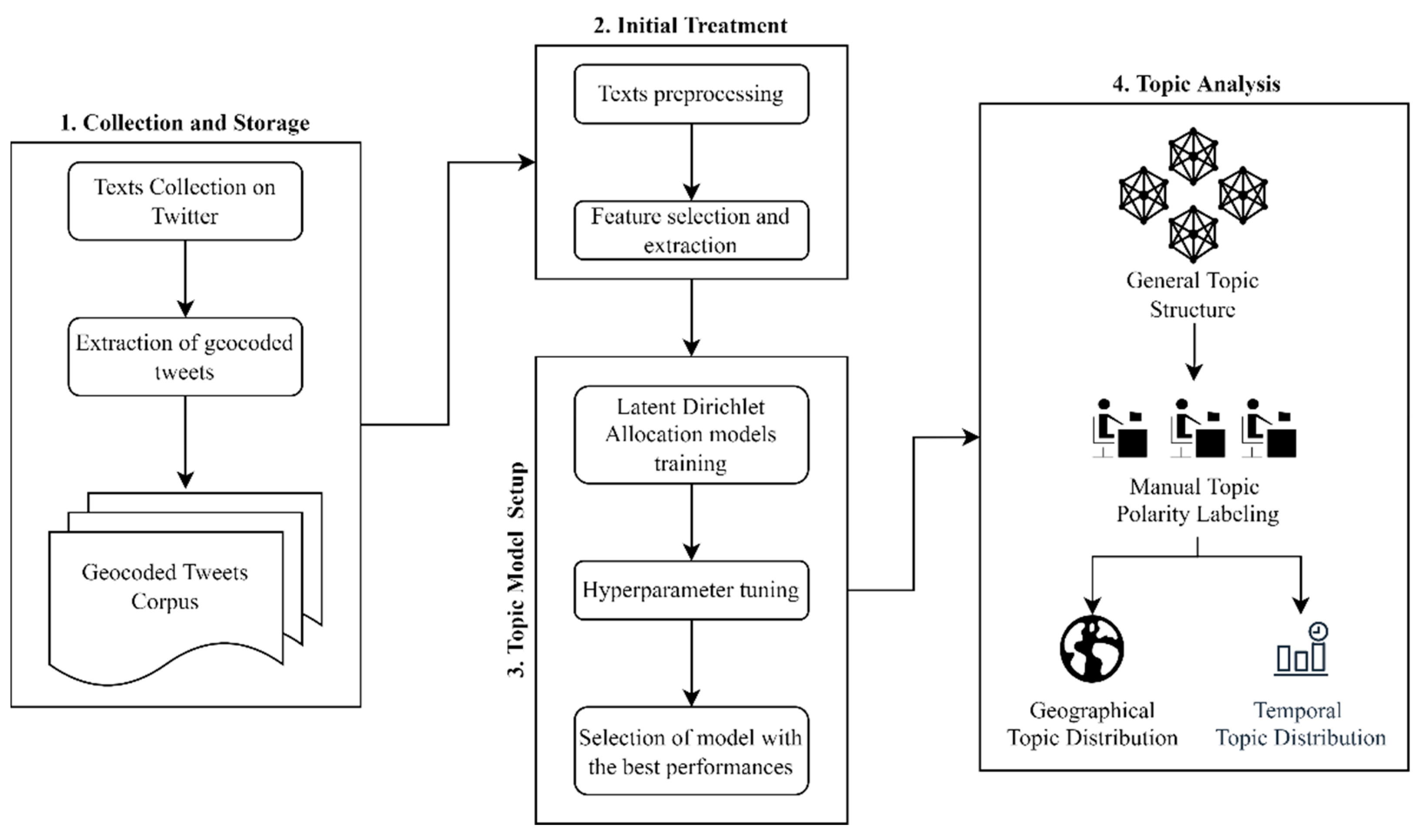
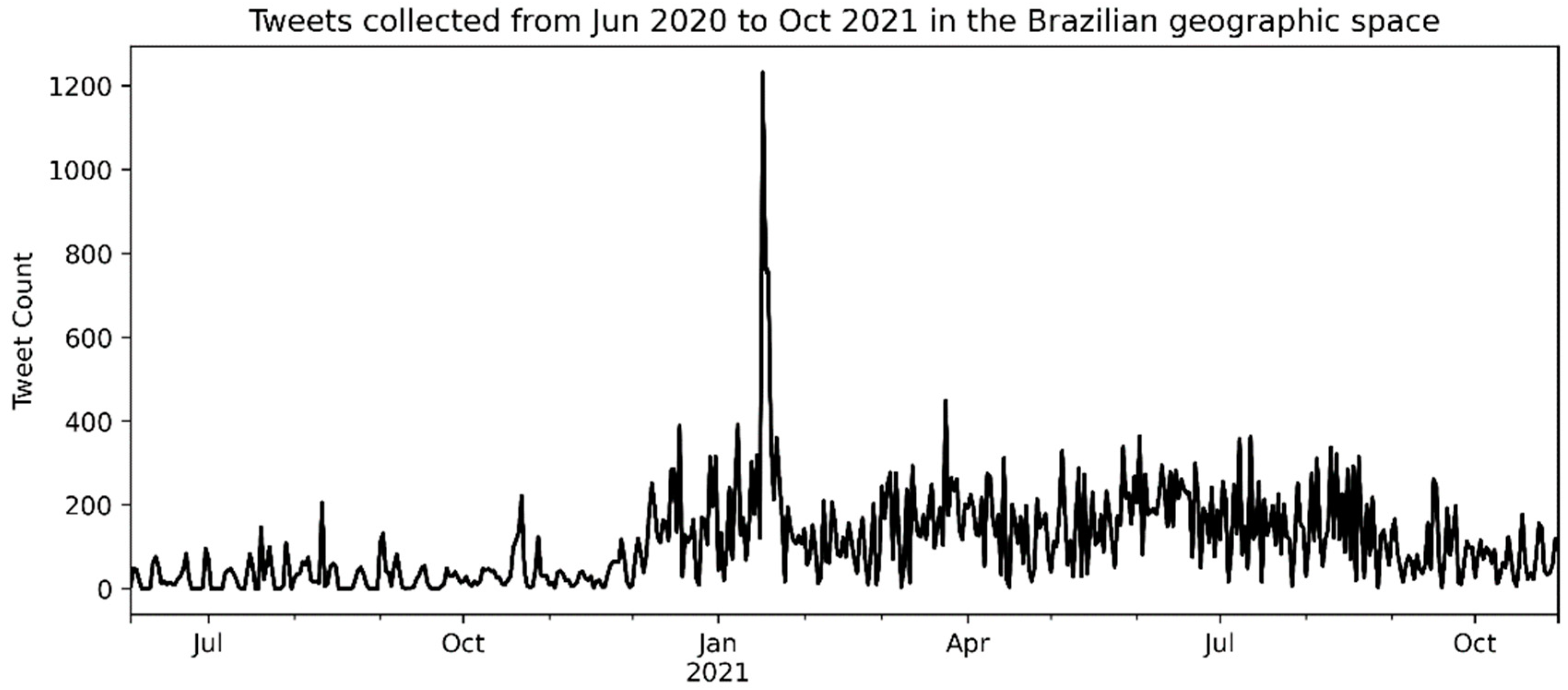

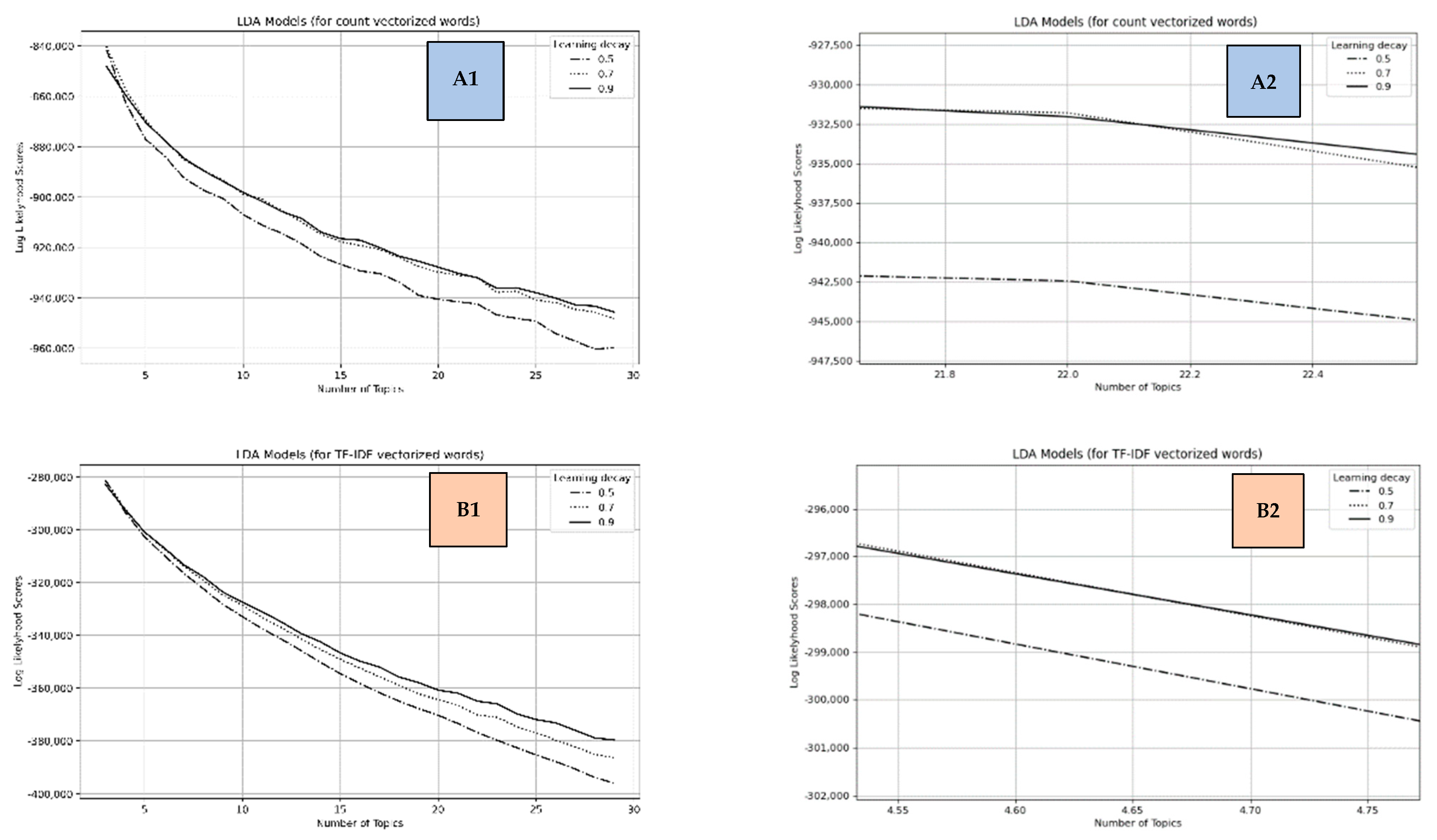
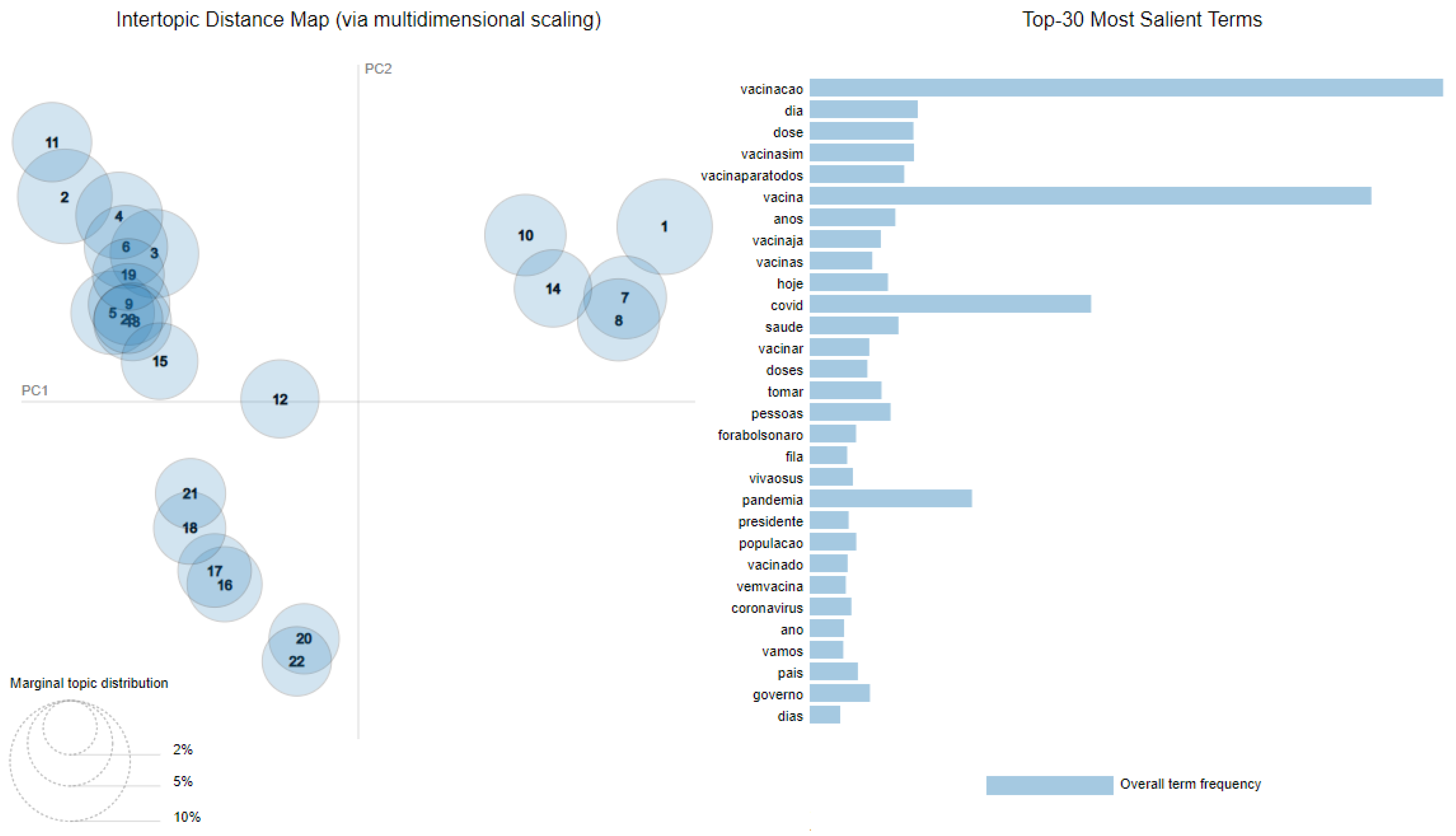
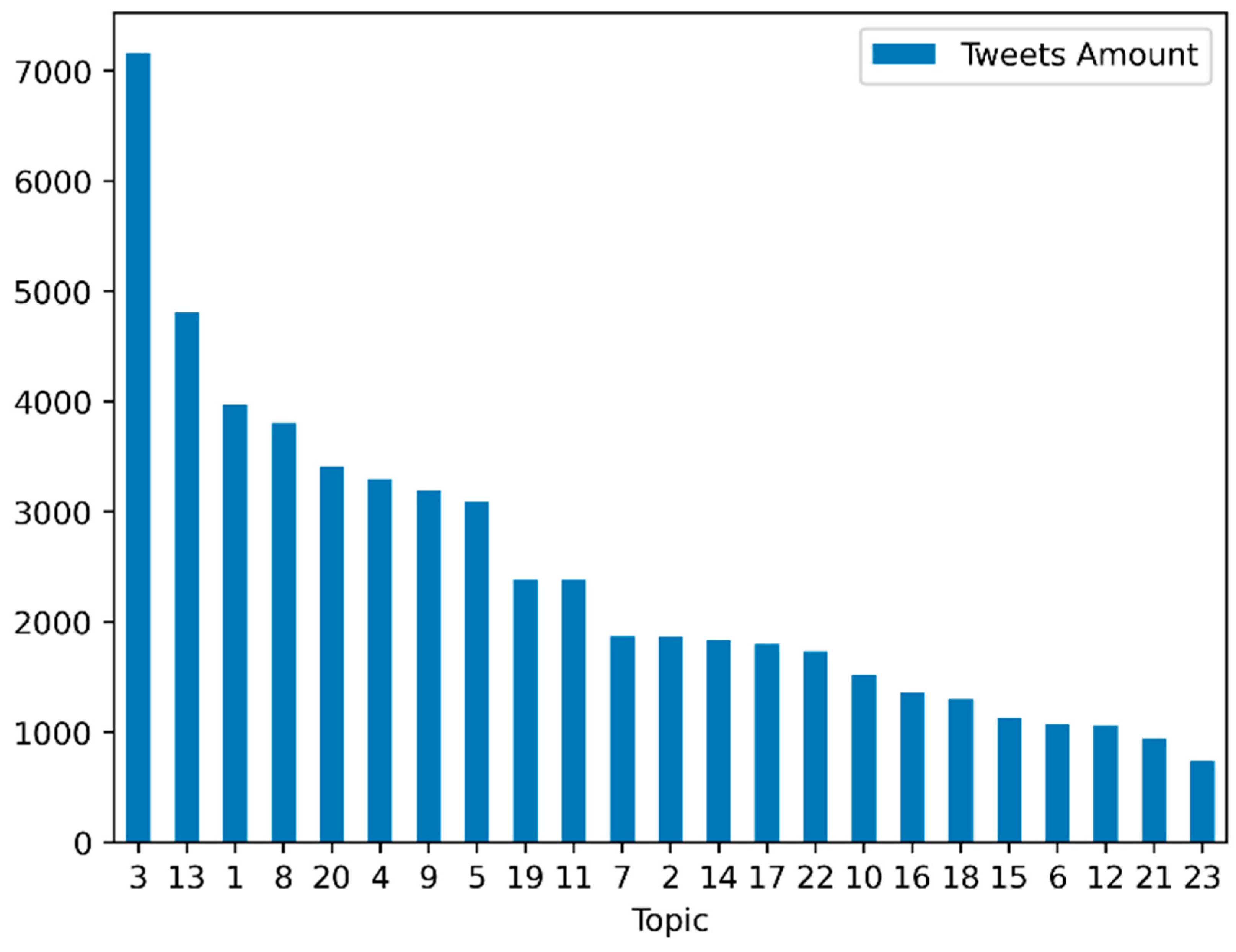

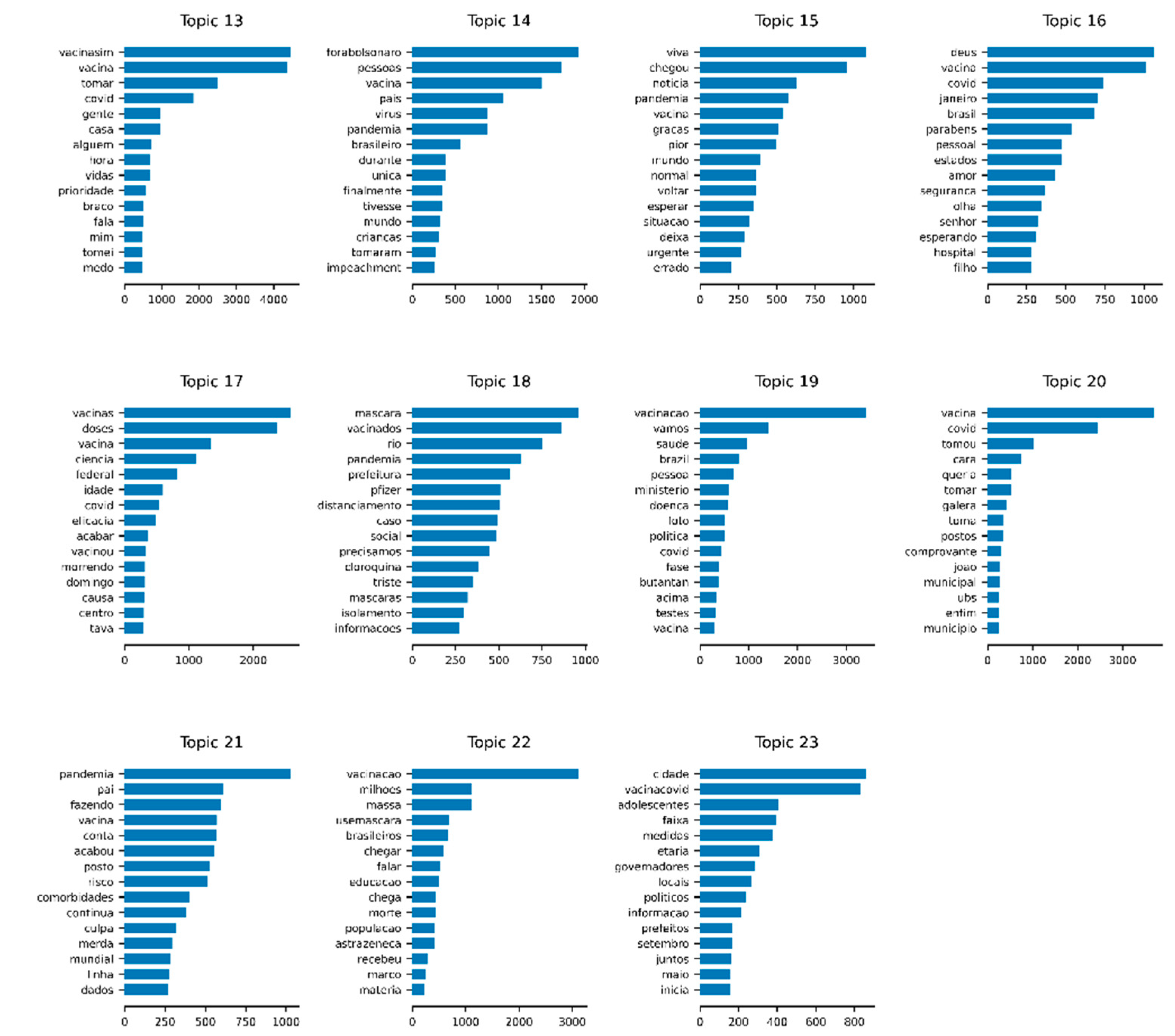

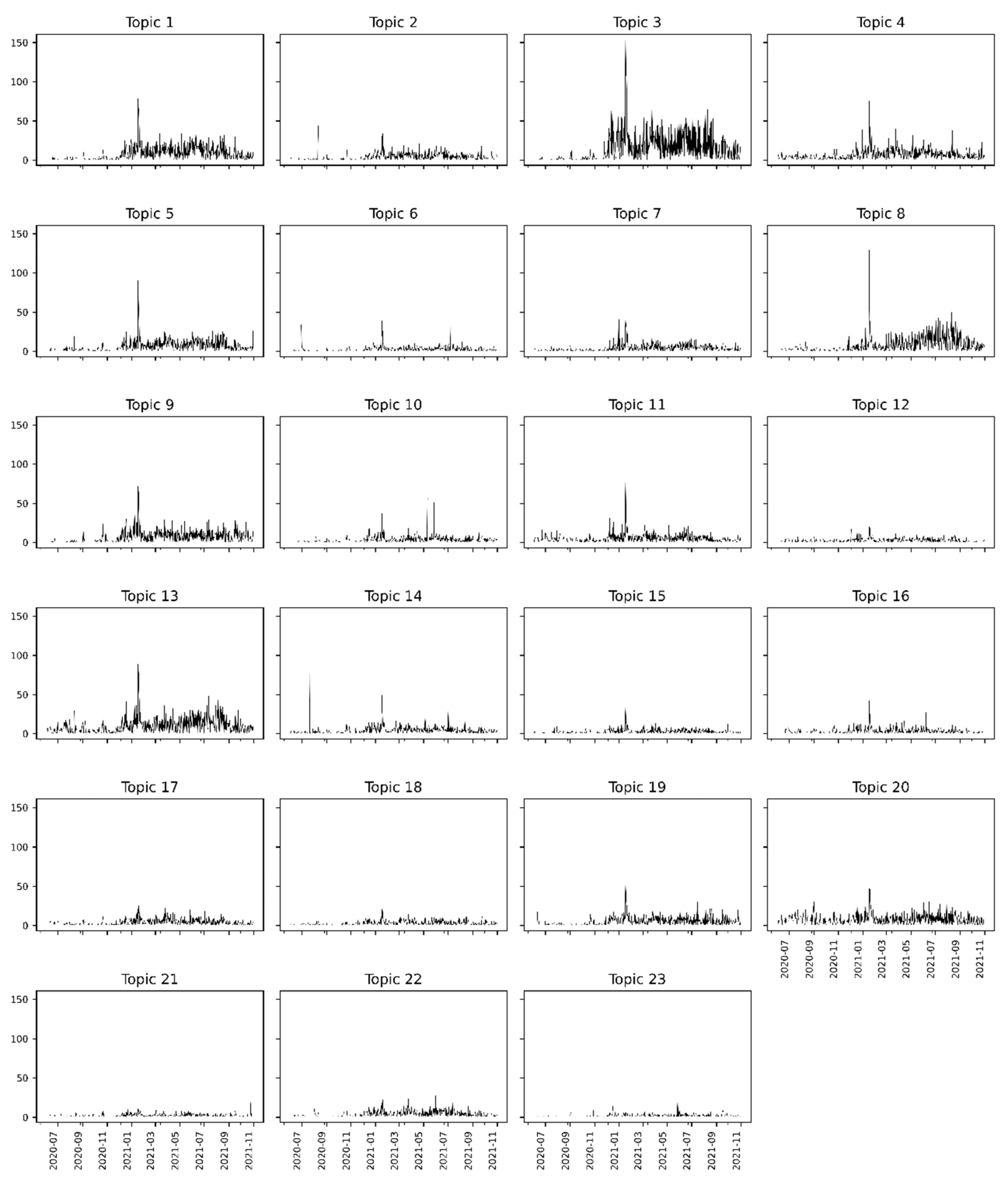
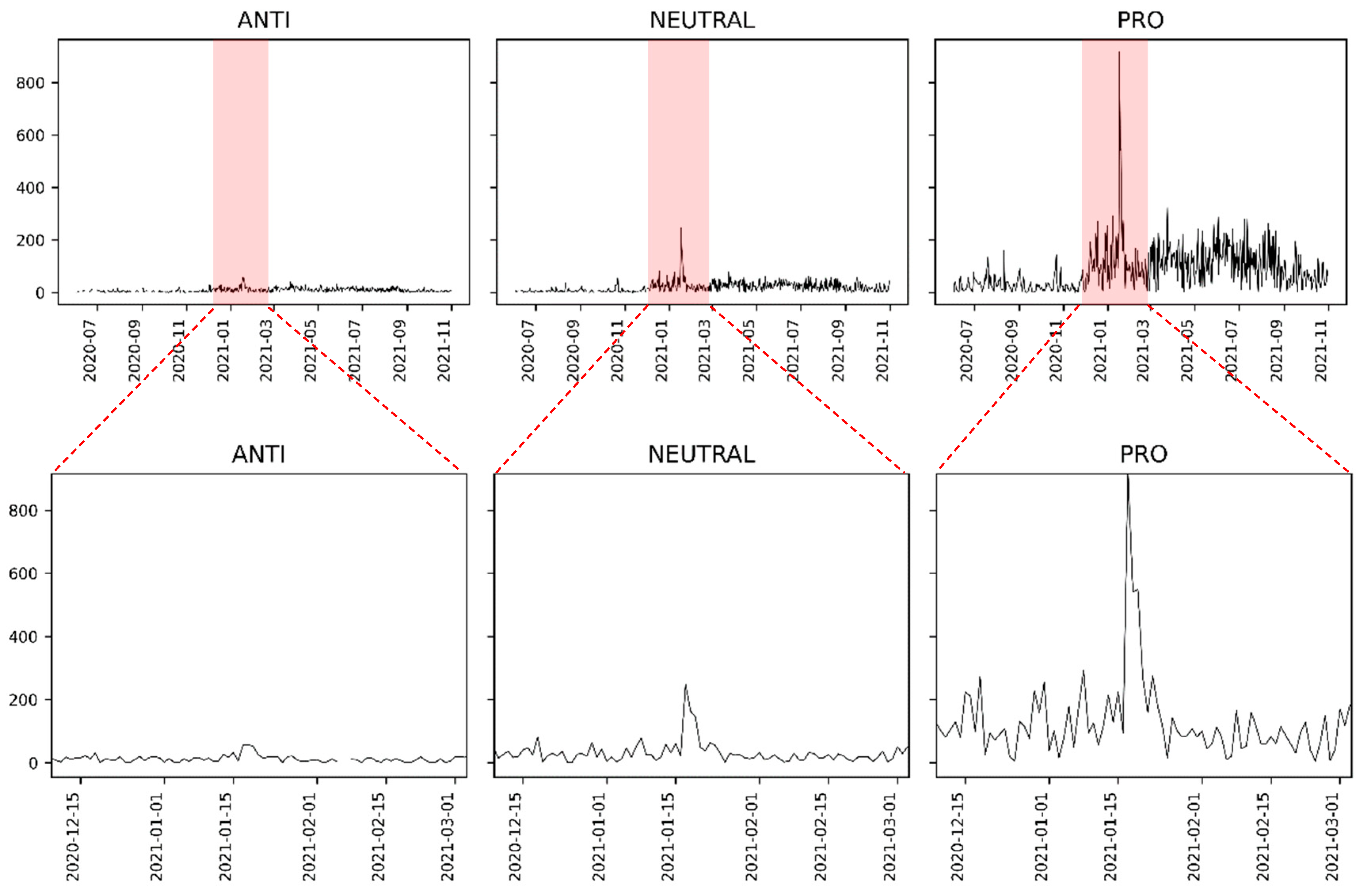
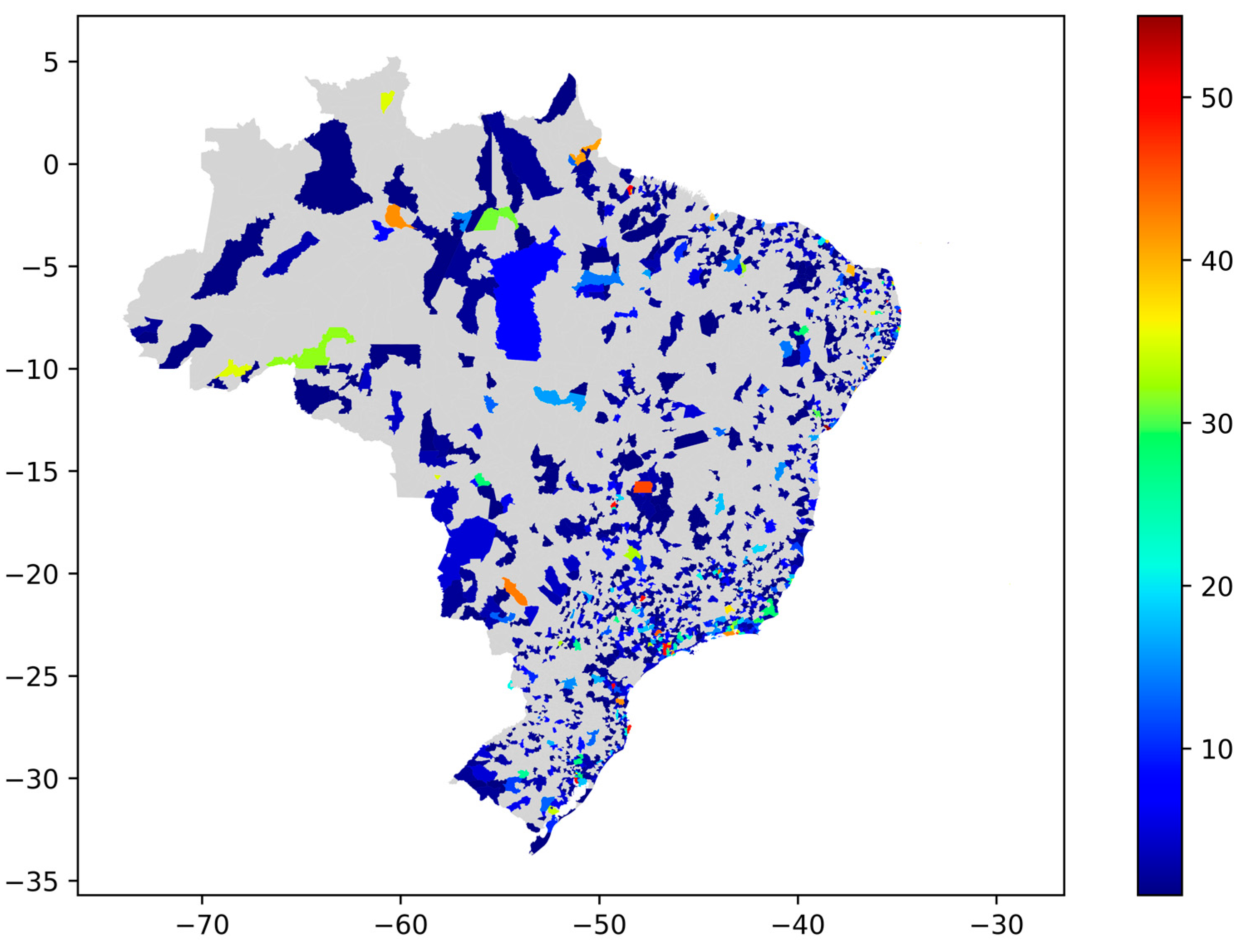
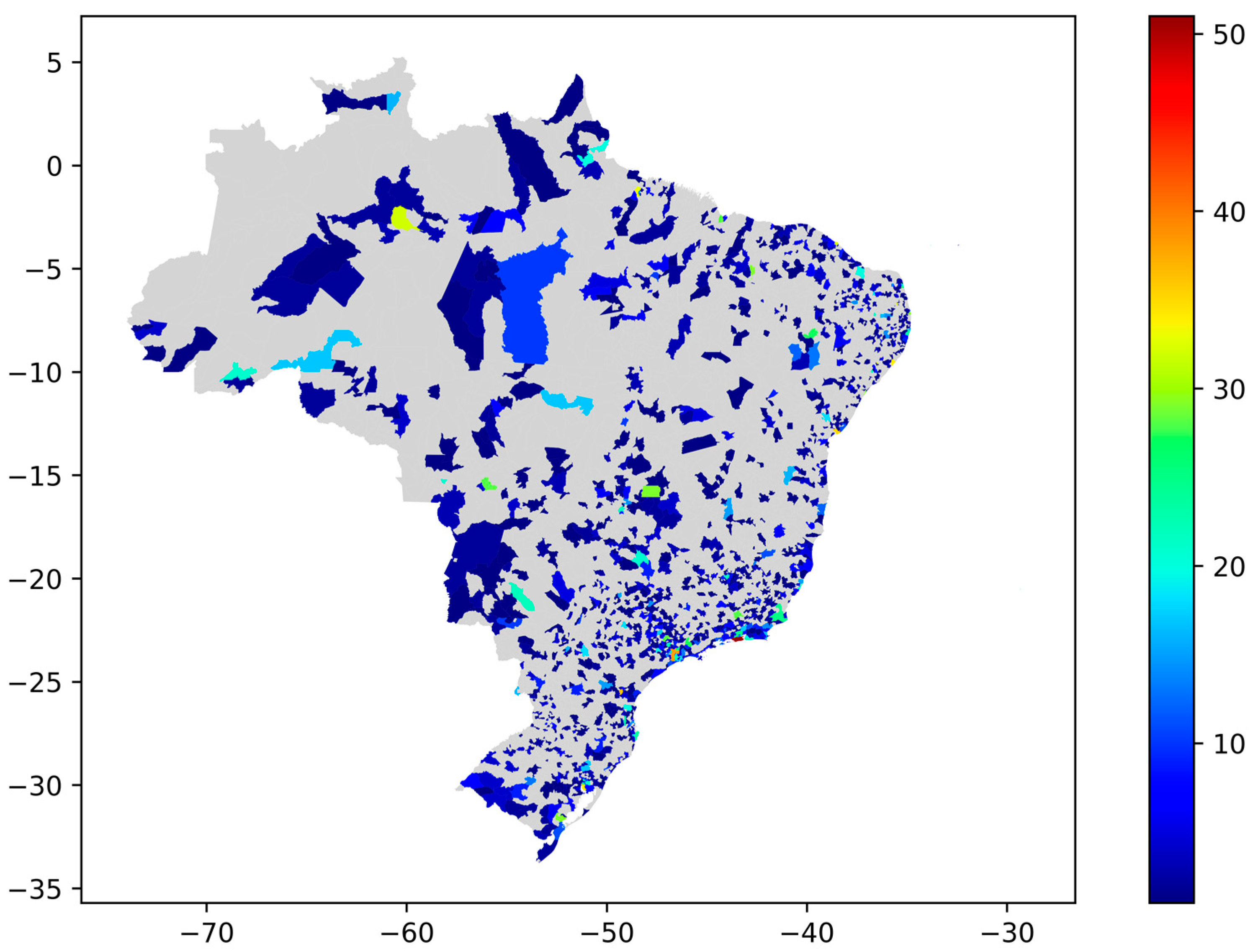
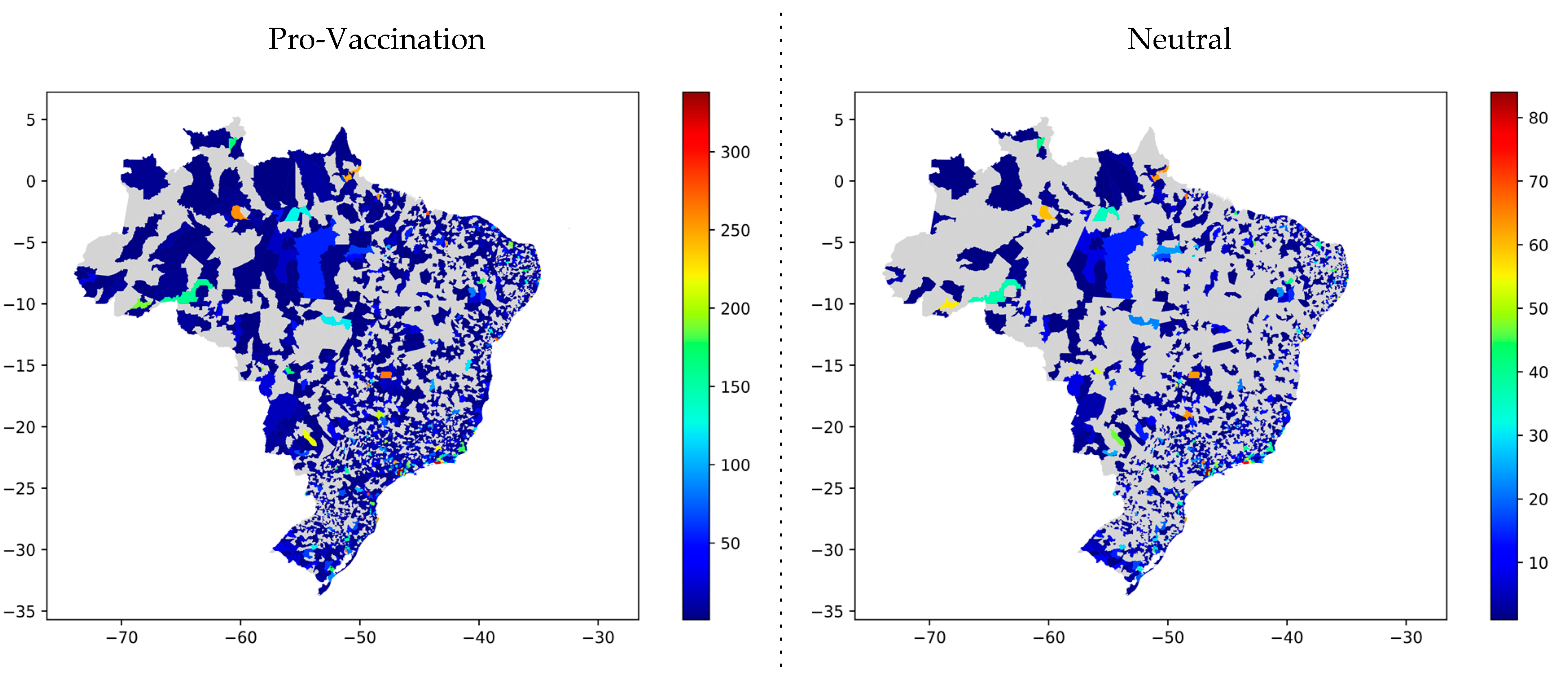
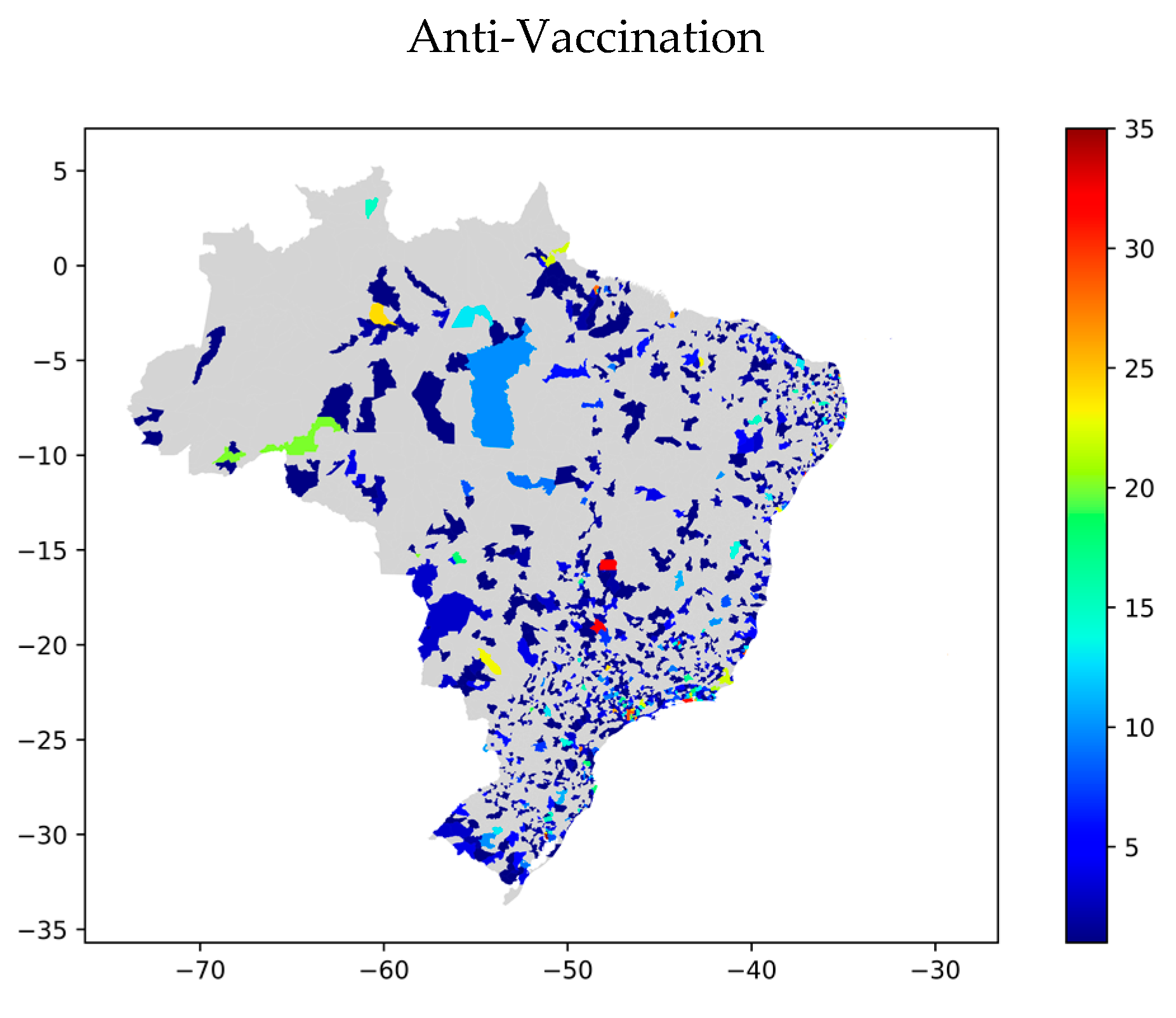
| Topic | Label | Topic | Label |
|---|---|---|---|
| 1 | Pro | 13 | Pro |
| 2 | Pro | 14 | Pro |
| 3 | Pro | 15 | Neutral |
| 4 | Pro | 16 | Neutral |
| 5 | Neutral | 17 | Anti |
| 6 | Pro | 18 | Anti |
| 7 | Pro | 19 | Pro |
| 8 | Pro | 20 | Pro |
| 9 | Neutral | 21 | Neutral |
| 10 | Pro | 22 | Pro |
| 11 | Pro | 23 | Pro |
| 12 | Anti | - | - |
| Pro | Neutral | ||||||
|---|---|---|---|---|---|---|---|
| City | Population | Count | Distribution * (%) | City | Population | Count | Distribution * (%) |
| São Paulo | 11,253,503 | 338 | 0.00300 | São Paulo | 11,253,503 | 84 | 0.00075 |
| Rio de Janeiro | 6,320,446 | 321 | 0.00508 | Rio de Janeiro | 6,320,446 | 78 | 0.00123 |
| Curitiba | 1,751,907 | 279 | 0.01593 | Belém | 1,393,399 | 67 | 0.00481 |
| Salvador | 2,675,656 | 276 | 0.01032 | Campinas | 1,080,113 | 66 | 0.00611 |
| São Luís | 1,014,837 | 273 | 0.02690 | Fortaleza | 2,452,185 | 65 | 0.00265 |
| Belo Horizonte | 2,375,151 | 269 | 0.01133 | Florianópolis | 421,240 | 64 | 0.01519 |
| Porto Alegre | 1,409,351 | 267 | 0.01894 | Brasília | 2,570,160 | 63 | 0.00245 |
| Goiânia | 1,302,001 | 266 | 0.02043 | Uberlândia | 604,013 | 63 | 0.01043 |
| Brasília | 2,570,160 | 265 | 0.01031 | Macapá | 398,204 | 63 | 0.01582 |
| Recife | 1,537,704 | 265 | 0.01723 | Salvador | 2,675,656 | 62 | 0.00232 |
| Anti | |||||||
| City | Population | Count | Distribution * (%) | ||||
| Porto Alegre | 1,409,351 | 35 | 0.0025 | ||||
| Brasília | 2,570,160 | 32 | 0.0012 | ||||
| Uberlândia | 604,013 | 32 | 0.0053 | ||||
| Rio de Janeiro | 6,320,446 | 31 | 0.0005 | ||||
| Belo Horizonte | 2,375,151 | 30 | 0.0013 | ||||
| Aracaju | 571,149 | 30 | 0.0053 | ||||
| Vila Velha | 414,586 | 29 | 0.0070 | ||||
| São Paulo | 11,253,503 | 29 | 0.0003 | ||||
| Recife | 1,537,704 | 29 | 0.0019 | ||||
| Belém | 1,393,399 | 28 | 0.0020 | ||||
Publisher’s Note: MDPI stays neutral with regard to jurisdictional claims in published maps and institutional affiliations. |
© 2022 by the authors. Licensee MDPI, Basel, Switzerland. This article is an open access article distributed under the terms and conditions of the Creative Commons Attribution (CC BY) license (https://creativecommons.org/licenses/by/4.0/).
Share and Cite
de Carvalho, V.D.H.; Nepomuceno, T.C.C.; Poleto, T.; Costa, A.P.C.S. The COVID-19 Infodemic on Twitter: A Space and Time Topic Analysis of the Brazilian Immunization Program and Public Trust. Trop. Med. Infect. Dis. 2022, 7, 425. https://doi.org/10.3390/tropicalmed7120425
de Carvalho VDH, Nepomuceno TCC, Poleto T, Costa APCS. The COVID-19 Infodemic on Twitter: A Space and Time Topic Analysis of the Brazilian Immunization Program and Public Trust. Tropical Medicine and Infectious Disease. 2022; 7(12):425. https://doi.org/10.3390/tropicalmed7120425
Chicago/Turabian Stylede Carvalho, Victor Diogho Heuer, Thyago Celso Cavalcante Nepomuceno, Thiago Poleto, and Ana Paula Cabral Seixas Costa. 2022. "The COVID-19 Infodemic on Twitter: A Space and Time Topic Analysis of the Brazilian Immunization Program and Public Trust" Tropical Medicine and Infectious Disease 7, no. 12: 425. https://doi.org/10.3390/tropicalmed7120425
APA Stylede Carvalho, V. D. H., Nepomuceno, T. C. C., Poleto, T., & Costa, A. P. C. S. (2022). The COVID-19 Infodemic on Twitter: A Space and Time Topic Analysis of the Brazilian Immunization Program and Public Trust. Tropical Medicine and Infectious Disease, 7(12), 425. https://doi.org/10.3390/tropicalmed7120425








